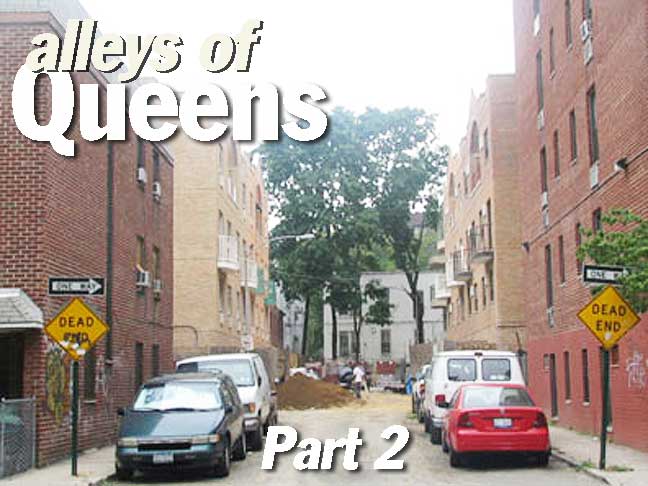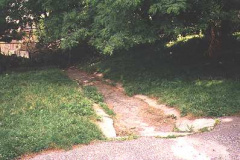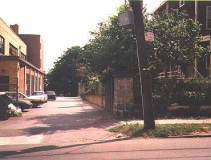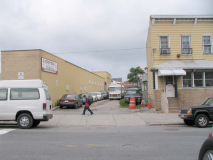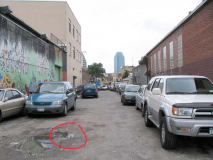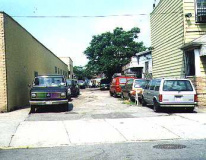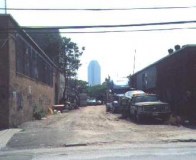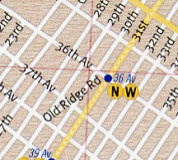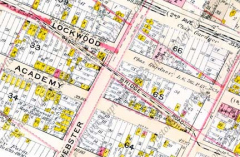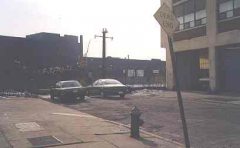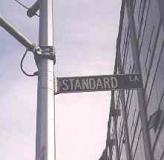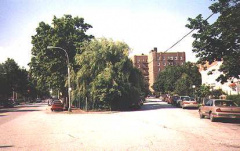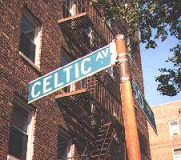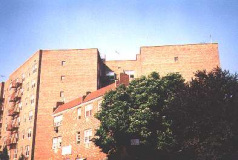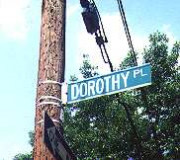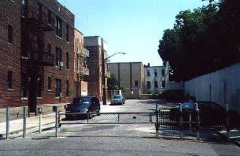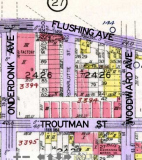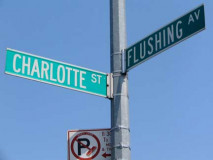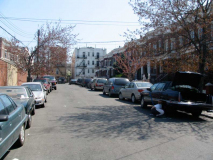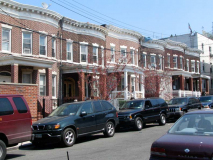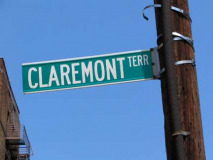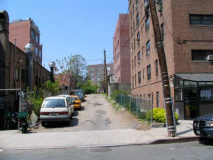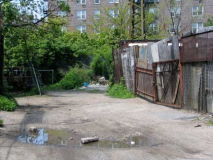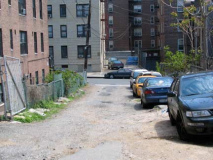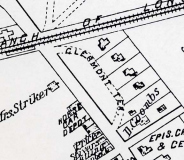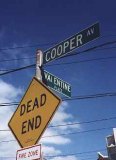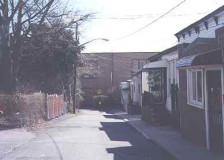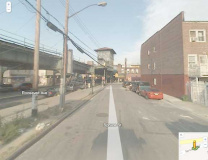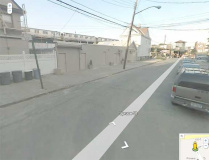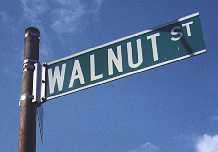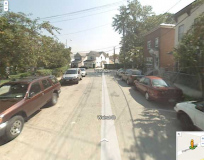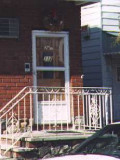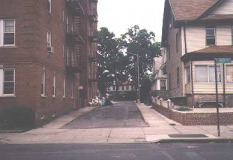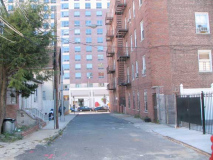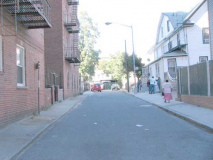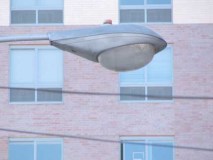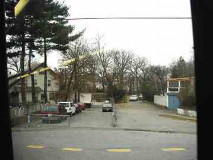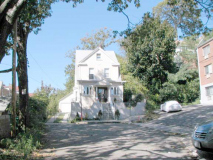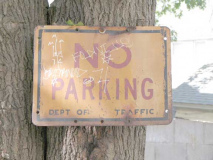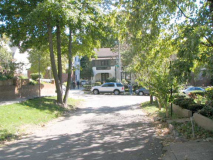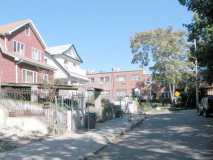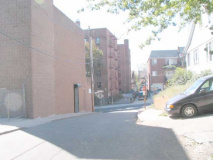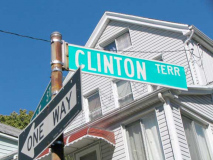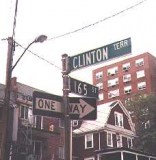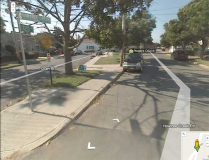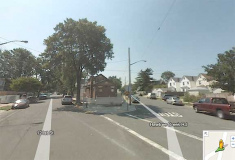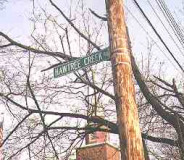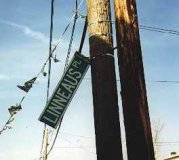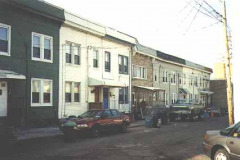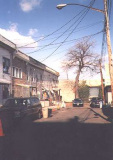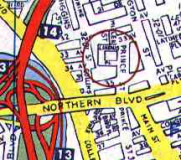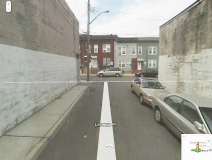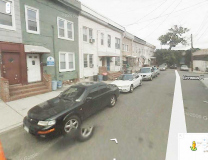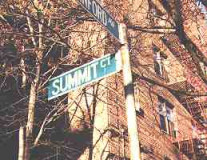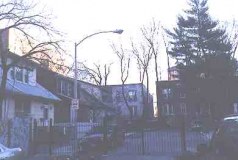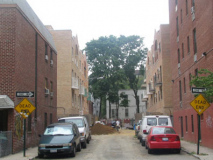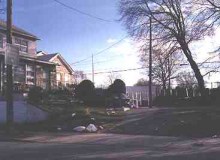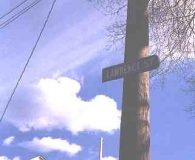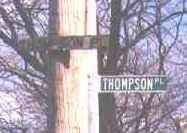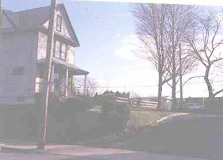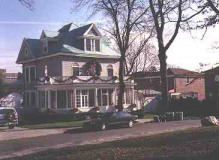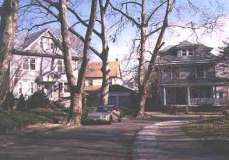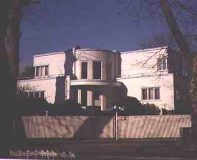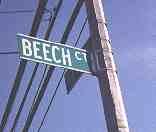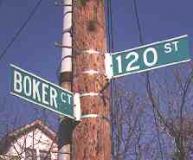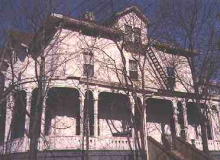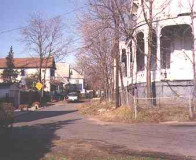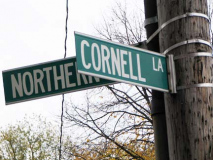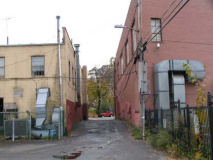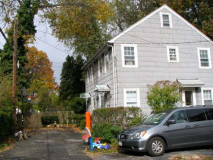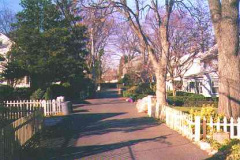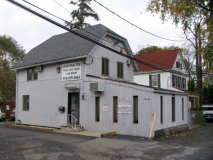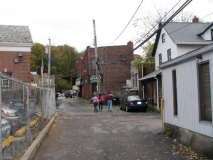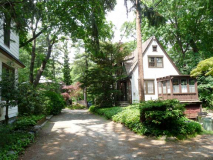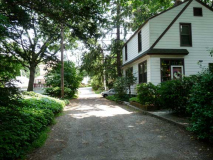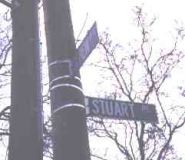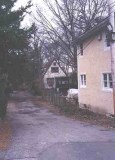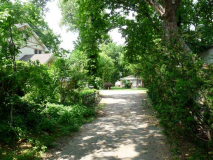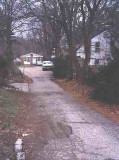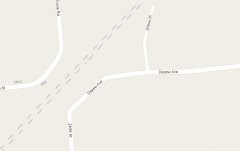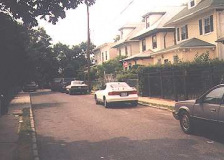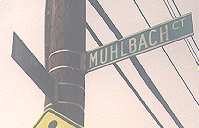This time, our survey of little-noticed Queens alleyways takes us from gritty, concrete-enveloped Long Island City all the way east to bucolic, rural Little Neck–which could pass for an upstate village or a small North Shore town, which, of course, it is! So let’s start in Long Island City and work our way east.
Blackwells Lane
Does this driveway lead to a hidden treasure? It could merely be a figment of my imagination. Old maps show a remnant called Blackwells Lane (probably named for the Blackwell family of nearby Blackwell [Roosevelt] Island fame) on 27th Avenue west of 12th Street, so I took a ride over there to check out my hunch.
I found a driveway in the place where Blackwells Lane should be. Nothing unusual, right? But if you walk down the driveway and peek in the foliage behind it…you find something interesting.
Is that little Belgian block lane Blackwells Lane? Maybe…
Old Ridge Road
One of the oldest streets in Queens points to one of its newest buildings, the 48 story Citicorp Tower.
Located between 29th and 30th Streets and 37th and 38th Avenues, Old Ridge Road, as identified on old maps, is the last piece of the original road of Long Island City…according to the Queens Tribune. It’s a humble driveway now, but it’s got a 200+ year history. The road once extended through Astoria as far as Newtown road and about 45th Street.
Close inspection will reveal an exposed trolley track. Doing some sleuthing in old maps, you find that this section of Old Ridge Road did once support a trolley route, likely explaining its continued existence — similar to Jackson Mill Road in Jackson Heights.
Standard Lane
Standard Lane along busy Northern Boulevard at 36th Street is among the busiest alleys in Queens. Standard Lane is named for the venerable auto parts distributor, Standard Motor Products, which had been in business on this site for over 80 years. The building is home to movie production studios and a rooftop farm.
Your webmaster freelanced in the art department at SMP in 1999.
Celtic Avenue
Celtic Avenue (at right in the picture) branches off from 43rd Street in Sunnyside.
An unusually-angled apartment building marks the former route of Celtic Avenue.
Once known as Old Bowery Bay Road and later, Celtic Drive, Celtic Avenue in Sunnyside is a remnant of a much longer road that once stretched to northern Astoria (Hobart Street, which leads from 31st to 28th Avenues near 51st Street in Astoria, is another remnant.) The neighborhood was once called Celtic Park in honor of Irish immigrants.
Dorothy Place
Dorothy Place, in Astoria, quietly dead-ends on 29th street northeast of Astoria Boulevard.
Charlotte Street
Tucked away on Flushing Avenue between Onderdonk and Woodward in an otherwise heavily industrial area of Ridgewood, Charlotte Street distinguishes itself by having well-kept, porched two-family homes, as well as its original red brick paving.
2004: no more brick paving…
By the way, this is not the Charlotte Street visited famously by President Carter in 1977, which became a symbol of urban blight. That Charlotte Street is in the Bronx, and is no longer blighted.
Claremont Terrace
A nearly-forgotten dirt road in Elmhurst, Claremont Terrace is a dead end on Dongan Avenue just off Broadway.
The only property fronting on Claremont Terrace in 1999 was this dilapidated house. It remained for a few more years, until it was demolished to make room for a real estate development taht has stood unfinished for the better part of a decade.
According to Bob Singleton of the Greater Astoria Historical Society, Claremont Terrace…
…was a row of houses built by Samuel Lord (of Lord & Taylor) for his daughters. The last one left (1854) built closest to the train for his least favorite. If you saw the four buildings in their heyday you would weep.
Valentine Place
Quiet Valentine Place makes for a serene interval near the busy intersection of Cooper Avenue and 80th street in Glendale.
Spruce Street
Spruce Street is a short alley in Elmhurst between 100th Street and the intersection of Roosevelt Avenue and 102nd Street.
Spruce Street seems to be the odd street out in his neighborhood, where all other streets besides Roosevelt Avenue and nearby National Street are numbered. Old maps show that other streets in this area also carried tree names like Oak and Elm before Queens’ numbering system was imposed in the 1920s.
Why did Spruce Street keep its old name when every other street in the area got a number? No one knows.
Walnut Street
A few miles south of Spruce Street, on the border of Glendale and Forest Hills, we find an oddity called Walnut Street, a one-block street of nicely-kept homes between 70th Drive and 71st Avenue just north of Union Turnpike. That Walnut Street carries a name and not a number is not unusual in this neighborhood…as a matter of fact, Walnut Street appears to be the final street in an alphabetical sequence that begins in downtown Forest Hills with Austin Street and continues with Burns, Clyde, Dartmouth, and so on.
What sets apart Walnut Street from most other streets in Queens is not that it carries a name…rather, its house numbers are a vestige of the Queens that existed previous to its present street numbering system.
Queens house numbers are immediately recognizable. They carry a hyphen which separates the street number from the house number. Thus, 77-25 105th Avenue (I’m just making this address up) is between 77th and 78th Street. This system applies for named streets as well; 77-25 Union Turnpike will be between the same two streets.
pictured: 98 and 112 Walnut Street
But Walnut Street breaks the rules, and breaks them in a way that makes it nearly completely nonsensical to people who don’t live in the neighborhood. In Queens, house numbers get higher the further east you go, because the numbers begin at the East River. On Walnut Street, however, the house numbers begin at Number 98 at 71st Avenue, and get bigger as you go west toward 70th Drive…for only half the block! At that point, the normal Queens numbering system takes over, and you have the 70-XX numbering system, in which the numbers decrease as you go west.
But wait…that’s not all! The exact reverse takes place on the north side of Walnut Street, as No. 112 can be found at the western end of the street. The numbers decrease as you go east until you arrive at the middle of the block…where the 70-XX numbers take over and increase until you arrive at 71st Avenue!
There’s not a more screwed up block in the whole city! As Cindy Adams says, “Only in New York, kids, only in New York.”
So what gives?
Walnut Street’s older homes probably maintain their older numbering system, that was in effect before the new numbering was imposed on Queens in the 1920s. Walnut Street’s newer homes, built after the Twenties, carry the ‘new’ numbering system with the hyphens.
Older numbers can occasionally be found in fading paint on some apartment buildings around Queens. The question is why the older homes on Walnut Street were never renumbered. Just another anomaly that we like to point out here on Forgotten NY!
Burdette Place
Edging into Jamaica, we find, near its historic downtown district, several old lanes in various states of repair or disrepair. One of them is Burdette Place, on 89th Avenue near Parsons Boulevard. Somehow I don’t think it has anything to do with Lew Burdette, the pitcher, but I could be wrong. Burdette Place is one of the few remnants of a NY&Queens County Railway trolley line, having once been part of its right of way.
Glenn Avenue
Glenn Avenue, which dead ends on 164th Street south of 85th Avenue in Briarwood, is another remanant of the trolley line. The line extended up 164th Street to Flushing, accounting for 164th’s width.
Park Crescent
Park Crescent, which most maps won’t acknowledge, is on 86th Road near 164th Street, which is itself a dead end street, sputtering to a close at the gates of nearby Captain Tilly Park, for which the crescent is named.
Clinton Terrace
Clinton Terrace climbs a hill on 165th Street near, rather appropriately, Hillside Avenue. It apparently used to have a partner named Clinton Place, but I found no trace of it.
Hawtree Creek Road
Hawtree Creek Road, seen cutting into 120th and 121st Streets, in South Ozone Park defies the strict street grid in the area, meandering from 109th Avenue southwest to 135th Avenue near Lefferts Blvd.
Or rather, the street grid defies Hawtree Creek Road! Old maps show that Hawtree is one of the first streets that existed in South Ozone Park. It was a cart path and wagon trail in the late 1800s, and after houses were constructed along its path, it couldn’t be completely eradicated like other roads in the area when the grid was cut through.
Linneaus Place
The western end of Flushing, Queens today is an uninviting mishmash of auto body shops, glass signs shops, asphalt plants and lumberyards, accented by the noxious Flushing River and congested, car-choked Northern Boulevard.
There used to be a time, though, when Flushing was renowned throughout the Northeast for its plant nurseries which gathered plants from around the world, one of which was even visited by President George Washington. Robert Prince emigrated from England in 1737 and planted eight acres in Queens just east of the Flushing River. (By the Civil War the Prince family’s holdings amounted to 113 acres.)
In 1793 William Prince Jr. (Robert’s grandson) established a new Prince nursery north of Broadway (today’s Northern Boulevard). When the two nurseries were combined, Prince had the idea to name it the Linnean Gardens, after the Swiss naturalist Carolus Linneaus, who devised the nomenclature we use for living species (ie. Homo sapiens, “wise man.”)
Other nurseries later sprang up in the 19th Century, notably Samuel Parsons’ nursery in 1838. Parsons brought a weeping beech tree from Belgium in 1847 and planted it where 37th Avenue is today. That tree became a living landmark, surviving until late 1998. The Parsons nursery has been gone since the late 19th century, but its memory lives on in Flushing street names: Ash, Beech, Cherry, Geranium, Mulberry and many more.
So where’s the alley? There’s a horseshoe-shaped alleyway on Prince Street (itself named for the Prince family) that is the last reminder of William Prince’s Linnean Gardens.
Residents of Linneaus Place do their best to maintain the 1921 row houses that line it. But it’s an uphill battle. The alley has no storm sewers and becomes a swamp after it rains. It hasn’t received a new pavement in many years and is full of potholes. And, it had no street lighting until just recently. The local community board is attempting to alleviate the problems.
Meanwhile, it’s the only way Flushing remembers the verdant Prince Linnean Nursery!
Summit Court
About a mile south of Linnaeus Place, on Sanford Avenue east of College Point Blvd., you will find the very obscure Summit Court. Residents had gated Summit Court off to protect its handsome one-family homes from the rest of the somewhat dicey surroundings. By 2005 Summit Court has utterly changed, and not for the better, with tract housing.
Why the street is called Summit Court escapes me, since the region is flat as a pancake. (1999)
Lawrence Street
If you weren’t looking for them, you wouldn’t notice them. Lawrence Street and Thompson Place are wedged between the Long Island Expressway service road and Mount Hebron Cemetery in Queensborough Hill, east of Flushing Meadows Park. It’s so obscure it even has an ancient street sign still intact on it!
But, Lawrence Street has a secret.
Until 1969, Lawrence Street was one of the busiest streets in Queens, stretching from Flushing all the way south to the LIE! But, that year it was decided to rename Lawrence Street, along with its northern extension, College Point Causeway, as College Point Boulevard. (And, coincidentally, the last”causeway” in Queens was eliminated; Strong’s Causeway, which carried trolleys through Flushing Meadows, had already been eradicated in favor of the LIE).
A short stretch of Lawrence Street remains above the LIE, as well as this short alley south of it.
Thompson Place
Thompson Place, marked by both a hand-lettered sign and a regulation green-and-white, resembles a lonely outpost on this stretch of the LIE, next to Lawrence Street (see above).
Beech Court
Beech Court is one of the most beautiful cul de sacs in Queens, with several spectacular examples of 20th Century architecture along its oval-shaped route. Located on 14th Avenue just west of College Point Blvd in College Point, its well kept homes beckon to oglers one and all.
Beech Court is tucked behind the Poppenhusen Branch of the Queens Public Library on what was once an estate belonging to Herman Funke. One of its residences is the Queen Anne masterpiece at right.
One of the more unusual homes on Beech Court is the “Art Moderne” classic at right that has been altered several times over the years. “Art Modernes” are distinctive, among other reasons, for having perfectly flat rooves. It is one of two Art Modernes in the area; the other one is on Malba Drive a couple of miles to the east. The style was introduced at the Paris Exhibition of 1937.
Boker Court
Nearby Boker Court, on 120th St. north of 14th Avenue, features a home that was apparently built in the middle of the street!
This is the awesome College Point Clubhouse, by 1999 was divided among several residents. It is the former Boker residence, after which the court is named. 2004: The Clubhouse was torn down to make room for tract housing.
Since it was built before the grid of streets in College Point were cut through, 120th Street curves around it. Another house in College Point, at 13th Avenue and 123rd Street, repeats this pattern.
Let’s wind down our Queens alleys tour with a visit to Little Neck, which is more a part of the ritzy North Shore of Long Island group of communites than it is a part of New York City. It’s rife with alleys and little laneways.
Cornell Lane
Northern Boulevard, one of the longest streets not only in New York City but in New York State, begins at Queens Plaza in Long Island City and continues, as Northern Boulevard, North Hempstead Turnpike and a variety of other names as Route 25 all the way to Orient Point on the north fork of Long Island. It passes through Little Neck where it begins to pick up steam as it roars into Great Neck and Manhasset. But on Northern Boulevard near Marathon Parkway, you couldn’t find a greater contrast than…
…quiet, imperturbable Cornell Lane, with its picket fences and well kept, tidy cottage-like houses!
Remnants of yet another ancient alley, Wright’s Lane, that bisected Cornell Lane, can be found nearby.
Jessie Court
A few yards east of Cornell Lane is a second cul-de-sac, Jessie Court, which contains rather fewer houses, although the building shown above, now housing doctors’ offices, was apparently the original station house of the nearby Long Island Rail Road Little Neck station.
Now here are a couple of all-time discoveries for me. I had never gone down Depew Avenue east of 240th Street, because it’s a dead end, after all, and I couldn’t get anywhere from there. But on a recent jaunt, I did indeed travel up Depew Avenue and, lo and behold, found two incredibly hidden laneways that all the mapmakers have missed. And that’s probably just how the residents like it.
Stuart Place (or Lane)
Stuart Place meanders north from Depew Avenue toward the LIRR, in a real You’d Never Believe You’re In NYC moment. Even Google Maps does not list it.
Willow Place
Stuart Place’s partner, Willow Place, is even more rural.
Muhlbach Court
Let’s beam down to Far Rockaway, about five or six miles south of Little Neck, where there are all manner of obscure roads and lanes, of which Muhlbach Court is just one. Unremarked by most mapmakers, but a college buddy lived on the court. I wonder where he is now.
There are more obscure alleys in Far Rockaway; I’ll return and find more soon.
That’s the end of our Queens Alleys tour…until I find more.
4/2/2000

